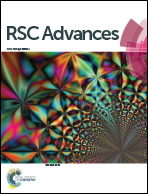Nanoparticle attachment on Ag nanorings and nanoantenna for large increases of surface-enhanced Raman scattering†
Abstract
A simple and inexpensive approach based on the heat-treatment of Ag+/PVA/PVP composite film on quartz glass has been developed for fabricating large-area Ag nanorings attached small nanoparticles. The explosive decomposition of AgNO3, PVA and PVP by calcination could explain their formation. A maximum enhancement factor of 1.9 × 1010 can be obtained with the self-organized Ag nanorings attached small nanoparticles. Moreover, using the three-dimensional finite-difference time-domain (3D-FDTD) simulations, we stipulate that the EF can be obviously improved via some small Ag particle attachment on these nanorings because of the strong coupling between the discrete plasmon states of the small nanoparticles and the term of propagating plasmons of the Ag nanorings. Understanding and realization of the enhancing mechanism of nanostructured surface attachment small nanoparticles could have potential to effectively improve the SERS property of the SERS substrates.


 Please wait while we load your content...
Please wait while we load your content...